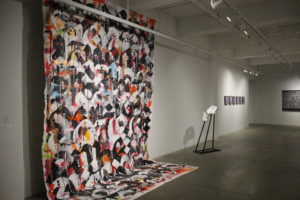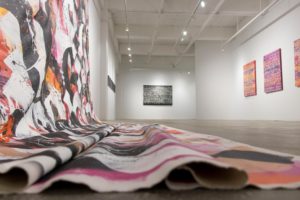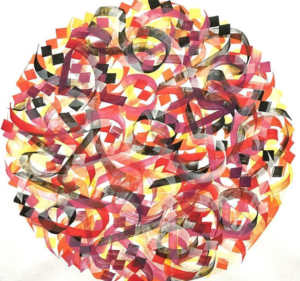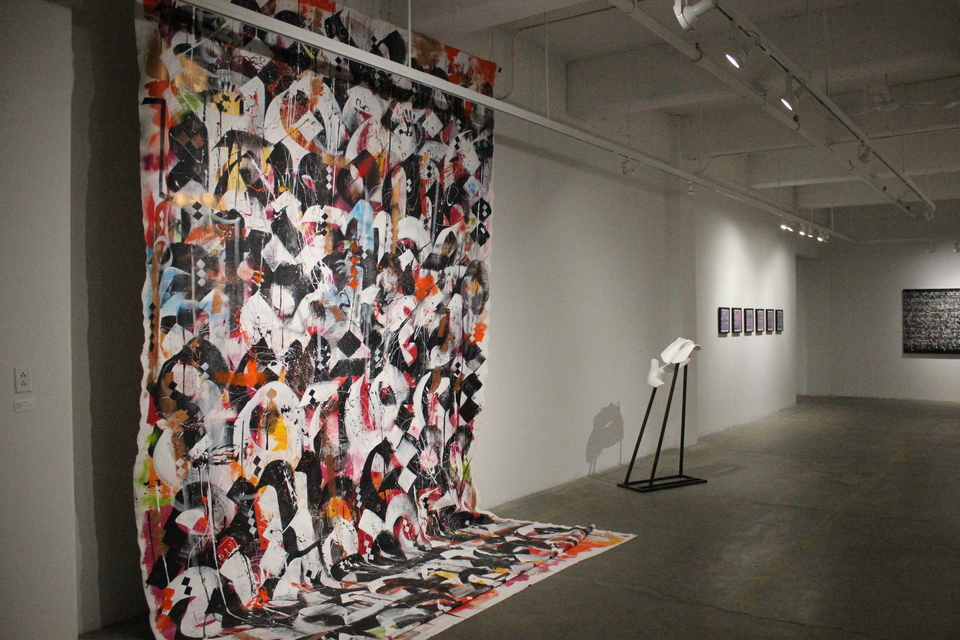Muhammad Zaman’s LUX at Buffalo Arts Studio
Zainab Saleh

Muhammad Zaman, a resident artist at Buffalo Arts Studio, has quietly been filling his corner studio with all kinds of magical experiments over the past two years. Working on the walls, on paper, on canvases large and small, the tight space is a veritable enclave of color and energy. Zaman, who immigrated to the United States from Bangladesh at a young age, uses his art to explore questions of identity and language–especially as they relate to being a Muslim man in America. Using a style that fuses the principles of traditional Arabic calligraphy and a street art aesthetic, Zaman employs a mixture of English, Arabic, and Bengali, layering letters into harmonious, if illegible, compositions. Zaman is very clear about the purpose of his work, seeing it as a response to negative perceptions of Islam and of Muslims. For him, the multilingual nature of the work (and his person) offers up potential for dialog. His blending of multiple languages serves to reiterate that Muslims don’t all speak the same language, even if Arabic is the language of the Qur’an, and in the incomprehensibility of the characters, Zaman challenges his viewer to recognize and appreciate a potential lack of understanding. His first full-length exhibition, LUX, is an unassuming presentation of these themes and ideas that continue to permeate his process.
Zaman borrows the word “calligraffiti” to describe his artistic mode, a term with uncertain origins, but one perhaps most notably employed right now by French Tunisian artist El Seed, who Zaman cites as an influence and mentor. It is also a term that, in its combination of calligraphy and graffiti, presents a sense of public space and public voice and divulges Zaman’s desire to be painting in the streets. Zaman’s work might be better placed in the category of hurufiyyah, a movement of Arab and Iranian art roughly dating to the 1940s, that abstracted the letter and positioned itself as a counterpoint to modern Western art. At the heart of this movement was a desire for freedom from actual and cultural colonizers, an expression of independence as well as individualism. Hurufiyyah was not a movement derivative of Islamic traditions of calligraphy, even if practitioners were often trained in those skills and found inspiration in the Arabic and Persian letter. Often, practitioners found themselves returning to the letter while living abroad: Hassan Massoudy in Paris, Madiha Omar in Washington, D.C. for instance. Zaman, and indeed El Seed as well, seem to be arguing for an expanded and contemporized, and perhaps culturally broadened, expression of this movement.
Like El Seed, whose massive swirls of color and letter might be found on structures big and small all over the world, Zaman finds a word or phrase to encode into his paintings. As mesmerizing as the resulting composition is, the mystery of the secret message presents a facade unto itself. Nowhere is this more evident than in Find Your Tribe and Love them Hard. Its measured, even lines of white and black letters dancing atop a dark background project an impossible legibility, and the flecks of gold, purple and red paint weave in and out creating a harmonious tapestry that bleeds off the sides of the painting. Zaman’s is very introspective work, and herein lies the tension between Zaman’s desire for it to be more public and the interiority it exhibits.

I found the woven quality of Zaman’s work explored more literally in Our Colors Make Us Beautiful. The elegance of the letters and writing find themselves bounded by a frame internal to the canvas, comprised of thin lines perpendicular to the edge of the painting, alternating between black and white, silver and gold, creating the illusion of a tasselled fringe to a carpet–or, alternatively, in the case of Ignorance is the Cause of All Fears, where top and bottom are crimped in white paint, a prayer mat. While these paintings lack the sense of infinity evoked by some of his other work, it is here and in his “moon” pieces that I find Zaman actively exploring a question at the crux of this exhibition.
Zaman actively desires to shine a positive light on his faith and fellow Muslims–and we might read that into his title LUX too–but at the heart of his work, Zaman seems to be investigating the tensions between cultural assimilation and identity. In his “moon” series, Zaman paints four phases of the moon, taking us through the lunar month with each stage, hitting upon a visual conception of seriality tied to the Islamic tradition, but also a temporality that illuminates the ebbs and flows of how words are read and how language accumulates meaning. Again, unlike his larger paintings where the letters continue, infinitely, off the edges of the canvas, these circular paintings seem more like snow globes, with the letters piled together in a jumble, pushing up against each other and the curved edge. These are interesting takes on shape poems, the chaos of letters illegible but recognizable as such. There is no gold here, exhibiting Zaman’s mastery of light, darkness, shadow, luminosity. I found Crescent particularly poignant, with the simplicity of the white background and black and grey letters gently ushering a new month, and the lone nuqta–a dot, serving as a diacritic mark–in the center like a star, connected by a silver thread to the rest of the letters.
I wonder if here is where we might read the condition of the immigrant in exile, projected out from country, community, language. After all, the hurufiyah movement began at a remove from the countries its artists came from, an attempt to make sense of that distance. Zaman’s unique blend of the three languages so crucial to his identity also presents a question multilingual speakers might find familiar: which one to use, and when? In Aftermath, which greets each visitor to the gallery first, Zaman’s strokes are large, his colors bold, the letters almost legible. I make out a “G,” I think. And the Arabic letter “Ha.” As I walk towards the enormous canvas spilling onto the floor, I feel the muscles in my throat clenching with each letter I recognize, mentally sounding them out. In this larger canvas, we see not only Zaman’s aspirations for this work to be wrenched out of the gallery walls to meet a wider audience on the streets, but also a recognition of language that takes forms other than linguistic–child-size hand prints punctuate the background, their literal imprints providing a counterpoint to Zaman’s gestural trace.

Zaman’s vision of his work extends outside the white walls of the gallery, and, indeed, walking towards the double glass doors of Buffalo Arts Studio with a large installation framed by the Buffalo Arts Studio entryway, it doesn’t take much to imagine his work adorning a wall or two flanked by a bustling street, the metallic paint he uses glinting in the sunlight. Inside the gallery, his work still accomplishes a very real function, allowing his viewers to spend time with the quietness in his work, and, additionally, allowing himself space for experimentation.
Photographs by Alex Shapiro.
Muhammad Zaman’s exhibition LUX is on view at Buffalo Arts Studio through September 7, 2018. It was made possible in part through Open Buffalo’s Emerging Artist program, a partnership between Buffalo Arts Studio and Open Buffalo, Inc.

